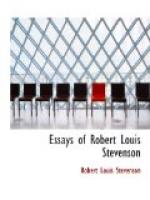From this defunct periodical I am going to reprint one of my own papers. The poor little piece is all tail-foremost. I have done my best to straighten its array, I have pruned it fearlessly, and it remains invertebrate and wordy. No self-respecting magazine would print the thing; and here you behold it in a bound volume, not for any worth of its own, but for the sake of the man whom it purports dimly to represent and some of whose sayings it preserves; so that in this volume of Memories and Portraits, Robert Young, the Swanston gardener, may stand alongside of John Todd, the Swanston shepherd. Not that John and Robert drew very close together in their lives; for John was rough, he smelt of the windy brae; and Robert was gentle, and smacked of the garden in the hollow. Perhaps it is to my shame that I liked John the better of the two; he had grit and dash, and that salt of the Old Adam that pleases men with any savage inheritance of blood; and he was a wayfarer besides, and took my gipsy fancy. But however that may be, and however Robert’s profile may be blurred in the boyish sketch that follows, he was a man of a most quaint and beautiful nature, whom, if it were possible to recast a piece of work so old, I should like well to draw again with a maturer touch. And as I think of him and of John, I wonder in what other country two such men would be found dwelling together, in a hamlet of some twenty cottages, in the woody fold of a green hill.
NOTES
This article made its first appearance in the volume Memories and Portraits (1887). It was divided into three parts. The interest of this essay is almost wholly autobiographical, telling us, with more or less seriousness, how its author “learned to write.” After Stevenson became famous, this confession attracted universal attention, and is now one of the best-known of all his compositions. Many youthful aspirants for literary fame have been moved by its perusal to adopt a similar method; but while Stevenson’s system, if faithfully followed, would doubtless correct many faults, it would not of itself enable a man to write another Aes Triplex or Treasure Island. It was genius, not industry, that placed Stevenson in English literature.
[Note 1: Pattern of an Idler. See his essay in this volume, An Apology for Idlers.]
[Note 2: A school of posturing. It is a nice psychological question whether or not it is possible for one to write a diary with absolutely no thought of its being read by some one else.]




